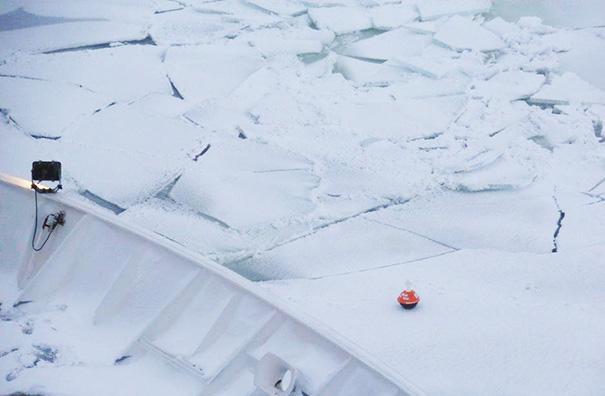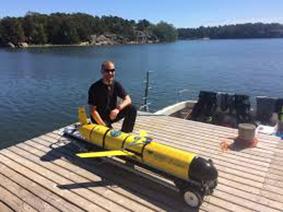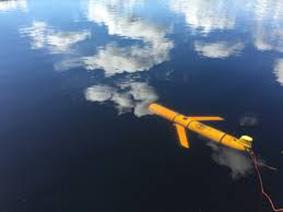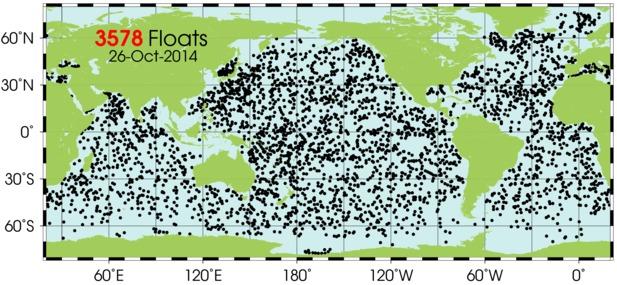Autonomous platforms
Finnish Meteorological Institute maintains a multiplatform marine observation network in the Northern Baltic Sea. The network includes Argo-floats for open sea hydrographic profiling, ice drifters, wave buoys, and bottom-mounted moorings for hydrography, currents and sea-ice thickness measurements. Most of the operational data is available through FMI open access data portal.
FINMARI partnership has established a network of 4 profiling buoys close to the four main field stations.
Argo Floats
Argo is an international observation system for measuring temperature, salinity, currents and bio-optical properties in oceans. The international program has been operational since the early 2000s. The observations are based on free-drifting profiling floats, operating autonomously for extended periods and delivering their data via satellite connection when visiting the surface. Currently, the global Argo fleet consists of almost 4000 drifting "Argo floats" worldwide (click the map below to see today's situation).
FMI operates three Argo floats in the Baltic Sea, two in the Bothnian Sea and one in the Gotland Basin. These Argo floats have been adapted to shallow water conditions.
One of the Argo-floats measures temperature and salinity profiles in the Bothnian Sea daily, while the other two are equipped also with oxygen and chlorophyll-a sensors and measure their profiles weekly.
Ice buoys
FMI uses GPS-Iridium ice drift buoys (MetOcean) to measure sea ice drift in the Baltic Sea. A buoy tracks its coordinates, air pressure and sea surface temperature (when in open water) every 3 hrs.

Every winter, 4-6 buoys are deployed on the sea ice at the Baltic Sea for validation of SAR imagery based sea ice drift and for operational sea ice monitoring.
Additionally, few buoys have also been deployed in the Arctic (e.g. two buoys to the central Arctic by German R/V Polarstern in August 2014).
Profiling buoys
Profiling buoys are automated devices for measuring salinity, temperature, dissolved oxygen,turbidity, chlorophyll-α, and blue-green algae content in the whole water column. A winch moves the measuring platform several times a day from surface to bottom, and the data are delivered wirelessly in real time.


FINMARI has moored four profiling buoys in the vicinity of each field station (Tvärminne /UHEL, Seili /UTU and Husö/ÅAU, Utö). The buoy network yields high-resolution data on seasonal stratification dynamics, which are important for the coupling of the productive surface layers and the seabed. These material fluxes are highly relevant for eutrophication dynamics of coastal systems.
Gliders
An ocean glider is an autonomous, unmanned underwater vehicle used for measuring physical and chemical parameters , e.g. temperature, salinity and chlorophyll, depending on the sensors they are equipped with. The glider "robots" regulate their buoyancy, diving at angle slowly to pre-set depth, rising again to the surface, and sending by satellite connection the data collected during the dive. Their mission can be remotely controlled by sending route commands during surfacing. They are suited for collecting data in remote locations, safely and at relatively low cost. The gliders are able to travel far distances over periods of weeks, even months, without servicing.


FINMARI consortium has currently one Slocum glider (FMI). The glider measures temperature, salinity, oxygen, chlorophyll, turbidity and organic carbon compounds (CDOM) in the water.
Links
Profiling buoy at Seili Archipelago Research Institute
Contact
Dr Laura Tuomi, Finnish Meteorological Institute
Simo-Matti Siirilä, Finnish Meteorological Institute: Argo floats
Marko Mäkynen, Finnish Meteorological Institute: ice buoys
Docent Heidi Pettersson, Finnish Meteorological Institute: wave buoys
Kimmo Tikka, Finnish Meteorological Institute: gliders
Pekka Alenius, Finnish Meteorological Institute: gliders
